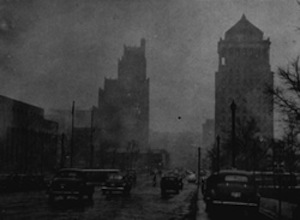Heating With Soft Coal Caused Black Tuesday 75 Years Ago Today

During the 1930s the population of St. Louis was declining, no doubt in part due to the unhealthy air during the winter months when soft coal was used to heat nearly every building.
In February 1937 a smoke ordinance was passed creating a “Division of Smoke Regulation in the Department of Public Safety”, forcing larger businesses to burn only clean coal and setting standards for smoke emission and inspection. By 1938 emissions from commercial smokestacks had been reduced by two-thirds. (Wikipedia)
Mayor Bernard F. Dickmann, the first Democratic Mayor in decades, put Raymond Tucker in charge of cleaning the air. In 1941 Dickmann lost the race for a third term, defeated by Republican William F. Becker:
Perhaps the most significant development during Becker’s term as mayor was the adoption of a civil service amendment to the City Charter. The amendment enacted a merit system for the hiring of city employees. Prior to that time, a political patronage system prevailed in which all city employees could be replaced with a change of partisan administration. Becker supported the civil service reform and it was approved by the voters in September 1941. Becker also retained Raymond Tucker who had been appointed Smoke Commissioner by Mayor Dickmann, and supported his efforts to reduce air pollution within the city. (Wikipedia)
Becker was killed in a glider accident just two years later, he was succeeded by the Republican President of the Board of Aldermen Aloys P. Kaufmann. Kaufmann was elected to a full term in 1945, he was the last Republican mayor in St. Louis.
I’m glad the citizens of St. Louis in the 30s & 40s took the big steps they did to clean the air. Today I don’t think we have the kind of political leadership that it takes to achieve such change.
— Steve Patterson
Talk about a reach.
The city population dropped less than 1% between 1930 and 1940. I’m sure air pollution was “no doubt” a reason for this. It wasn’t like anything else was going on in the 1930s, right?
Lately, each post here is more goofy than the last.
Goofy? There are many reasons why those who could afford to began leaving the city. The drop might have been small in total buy many more middle & upper income residents left, offset by lower income residents.
Other than pollution and overcrowding, what else was going on in the 30s that would have compelled people with means to move farther away from the city core, in your estimate?
How do you know people moving away from the city core? Perhaps families were not having as many children during the Depression? I don’t know. Neither do you.
What I do know is that less than 1% is a statistical hiccup. To conclude that that a population drop was “no doubt” due to dirty air is comical.
…..don’t forget about the parenthetical qualifier, “IN PART”….. With use of the qualifier, even if only one person moved because of the dirty air, then Steve’s statement is logically correct. So….. no comedy was attempted or accomplished, Mr. Becker!
Hypothesis, perhaps. Logically or empirically proven fact, no way.
Such a qualifier does not permit really stupid statements.
This had been the pattern for decades. In the 19th Century Lucas Places www established outside the dirty congested core, it was West of 14th St.
“The last residence to be built in Lucas Place was the home of Julia Chouteau Maffitt in 1877. The Lucas family no doubt expected Lucas Place to survive longer than it did, but by the mid-1880s the wealthy residents were again moving westward to more exclusive neighborhoods and Lucas Place slowly began to decline.
The area was rapidly becoming a boarding house district during the 1890s when Lucas Place became an extension of Locust Street as a result of the alteration of Missouri Park and the cut through of Locust Street.
By 1912, only a few Lucas Place houses remained. The headquarters of the General American Life Insurance Co. opened across the street from the Campbell House in 1912. The YWCA opened in 1906 and the YMCA in 1927. Most Lucas Place residents began selling their homes and moved west to neighborhoods like Vandeventer Place and the Central West End. When Hazlett Campbell died in 1938 the Campbell House was the only residence left standing in Lucas Place.” http://www.campbellhousemuseum.org/history/lucas-place/
Well then it’s a good thing you’re the fact police, I guess. It’s documented that those with the means to do so were moving westward out of the dirty, overcrowded city core. As Steve said, that movement created many of the private places. Regardless, you could make your point without being a jerk. I find it funny that so many of you seem to frequent Steve’s blog just to be assholes to him when you could just choose not to read it.
I’m used to it, part of the territory.
I should’ve mentioned the city’s first atempt at smog control was 46 years esrlier, in 1893. By 1939 the population had almost doubled, meaning the smog was much worse.
Many reasons why people moved, the same reasons why they had for decades: increasing industry closing in on residential areas, desire for new housing, etc.
This is why Tennessee Williams referred to St. Louis as St. Pollution. This is what it was like when he was growing up.